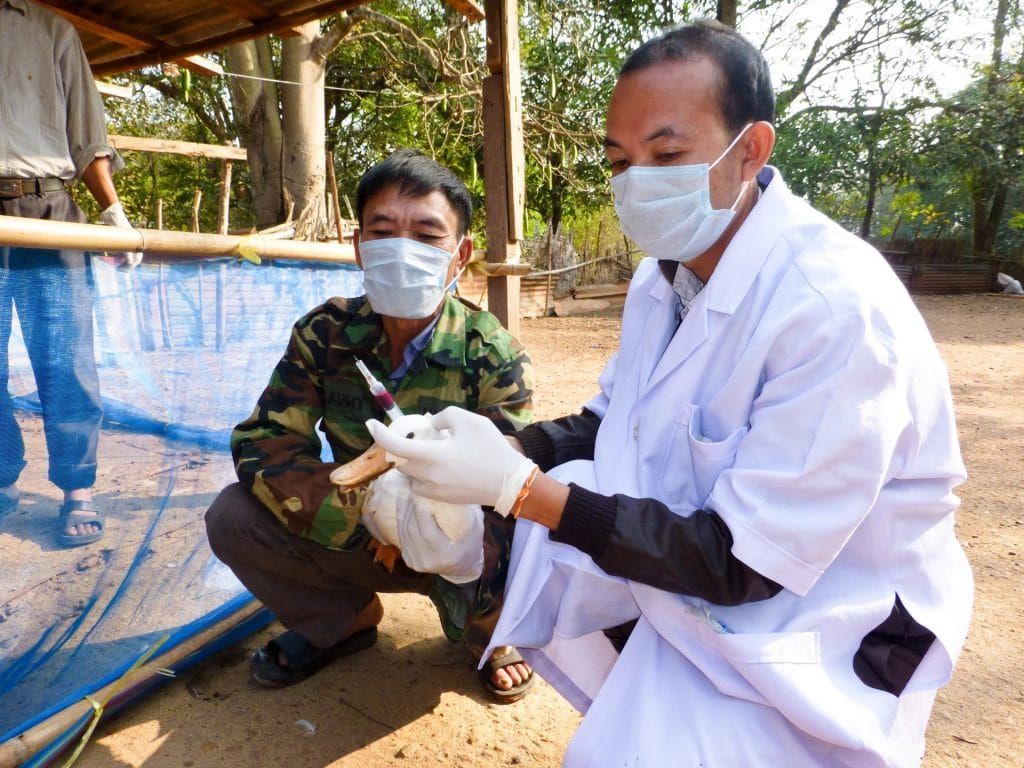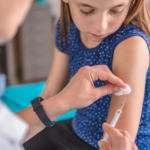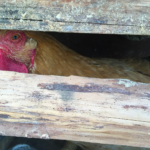Creating dangerous viruses in the lab is a bad way to guard against future pandemics
By Laura H. Kahn | November 19, 2021
 USAID animal disease surveillance work in Asia. Credit: Richard Nyberg / USAID. Credit: CC BY-NC 2.0.
USAID animal disease surveillance work in Asia. Credit: Richard Nyberg / USAID. Credit: CC BY-NC 2.0.
In 2011, three top US government scientists penned an opinion piece in The Washington Post arguing why research modifying highly pathogenic avian influenza (H5N1) was a worthy undertaking. At the time, the National Institutes of Health (NIH) was facing blowback over having funded experiments that modified the virus to be transmissible among ferrets. The scientists argued that eliciting potentially dangerous mutations in the virus was necessary to protect humanity, should those mutations evolve naturally.
“We cannot predict whether or not something will arise naturally, nor when or where it might appear. Given these uncertainties, important information and insights can come from generating a potentially dangerous virus in the laboratory,” wrote Anthony Fauci, the head of the National Institute of Allergy and Infectious Diseases, Francis Collins, the head of NIH, and Gary Nabel, then a top official at Fauci’s institute.
Amid the controversy generated by this influenza research, the US government implemented a “pause” on federal funding in 2014 for selected research reasonably anticipated to increase transmissibility or pathogenicity of influenza, SARS, and MERS viruses. These were experiments that fell within a subset of scientific study called “gain-of-function” research. In 2017, the government lifted the pause and put in place a requirement that the US Department of Health and Human Services conduct a risk-benefit assessment on research that could confer these attributes to potential pandemic pathogens.
The federal government continues to fund such experimentation, but, as scientists, media, and online sleuths have delved into the origins of COVID-19, they have revealed weaknesses in past and current government oversight of projects modifying viruses. The revelations have underscored the degree to which gain-of-function research in the name of predicting pandemics is an idea that doesn’t seem to fade.
US-funded coronavirus bioengineering. In 2018, EcoHealth Alliance, a US-based nonprofit research organization, submitted a grant proposal to the Defense Advanced Research Projects Agency (DARPA) called DEFUSE: Defusing the Threat of Bat-borne Coronaviruses asking for over $14 million for a three-and-a-half year project to, as the name suggests, prevent a bat coronavirus from spilling over into people and seeding an outbreak. The team would study “viral evolution and spillover risk[s]” of SARS-related bat coronaviruses by collecting viruses from caves in Yunnan, China and doing experiments that included testing hybrid, lab-created bat coronaviruses on mice engineered to have human receptors.
One eye popping segment in the 2018 EcoHealth proposal to DARPA dealt with finding so-called “furin cleavage sites.” In SARS-CoV-2, the virus that causes COVID-19, a furin cleavage site allows its spike protein to be cut by the furin enzyme present in human airway tissues, making the virus better able to infect cells than others without the feature. The furin cleavage site represents a crucial difference between the COVID-19 virus and its relatives, including SARS-CoV, the virus responsible for the 2003 outbreak of that respiratory disease.
The process by which viruses hijack the cellular machinery of their hosts to reproduce themselves is sloppy, and the viruses that a cell produces aren’t always identical to the ones that infected the cell to begin with. This sloppiness helps the virus to evolve and adapt to new hosts—such as us. The furin cleavage site in SARS-CoV-2 could have evolved in this way.
Some proponents of the idea that the pandemic began with a lab accident in Wuhan, however, wonder whether the furin cleavage site’s presence in the COVID-19 virus is simply a mark of natural viral evolution—an artifact of sloppy viral reproduction—or rather is something else entirely: a sign of human bioengineering.
DARPA did not approve EcoHealth’s 2018 proposal, and it’s unknown whether the project received other funding. But the EcoHealth proposal, like another of the organization’s collaborations with the Wuhan Institute of Virology that did get government funding, show the enduring interest scientists have in modifying viruses in the name of predicting pandemic pathogens. (NIH officials have denied that EcoHealth’s NIH-funded research is gain of function research, although NIH documents show that the organization failed to adhere to terms related to enhanced viral growth in its hybrid bat coronavirus studies. There is significant debate on what the definition of a dangerous gain-of-function experiment is.)
Predicting pandemics through gain-of-function research. An overarching goal of EcoHealth’s work—as documented in the DARPA proposal and in other projects—was to learn which viruses were poised to spill over, in other words, to predict pandemics. Predicting how and when the next pandemic could arise is important, but tampering with viruses to do so is the wrong way to go about it. Predicting pandemics isn’t like predicting the weather.
Weather prediction is a purely observational exercise. We have satellites and other tools to track weather to predict hurricanes. The forecast process begins with observations. Scientists use this data to develop hurricane forecast models. Geophysical fluid dynamics are well understood, based on the laws of physics (i.e. density, flow velocity, pressure, and temperature) enabling scientists to develop atmospheric and climate models.
Scientists do not experiment on clouds to see if they can cause hurricanes.
In 2004, the National Academy of Sciences published its seminal report, Biotechnology Research in an Age of Terrorism. It listed seven experiments of concern that should not be done.
- Demonstrate how to make a vaccine ineffective
- Confer resistance to antibiotics or antiviral agents
- Enhance a pathogen’s virulence or make a non-virulent microbe virulent
- Increase transmissibility of a pathogen
- Alter the host range of a pathogen
- Enable a pathogen’s ability to evade diagnostic or detection modalities
- Enable the weaponization of a biological agent or toxin
Bioengineering SARS-related coronaviruses in ways that could increase efficient infection of human cells and that increase viral load, pathogenicity, and lethality in mice genetically engineered to have respiratory cells with human features, i.e., humanized mice, as NIH documents show was done by EcoHealth Alliance and its Wuhan partners, would conceivably implicate points 3, 4, and 5 of the 2004 report. Whether the Wuhan experimentation was gain of function is a matter of debate, but some scientists disagree with NIH’s assessment that it wasn’t.
Ideally, Congress should hold a hearing to debate what kind of research should not be done and do more to investigate the origins of the pandemic. Certainly, there have been calls to do so.
There are other less risky ways of preventing pandemics than conducting gain-of-function research on pathogens. Many pathogens capable of causing human outbreaks originate in animals, and surveillance of wild and domestic animals for signs of illness makes sense. This is the One Health approach. With One Health, the goal is to prevent the spread of deadly zoonotic microbes into humans through improved communication and collaboration between human and veterinary medicine.
Preventing pandemics through rapid identification and response is an important goal; the One Health approach that emphasizes animal and human health and disease surveillance is the key to doing this, not risky gain-of-function research.
Author’s note: Many thanks to Richard Ebright, Board of Governors Professor of Chemistry and Chemical Biology, Waksman Institute, Rutgers University for his invaluable comments and links to technical references.
Together, we make the world safer.
The Bulletin elevates expert voices above the noise. But as an independent nonprofit organization, our operations depend on the support of readers like you. Help us continue to deliver quality journalism that holds leaders accountable. Your support of our work at any level is important. In return, we promise our coverage will be understandable, influential, vigilant, solution-oriented, and fair-minded. Together we can make a difference.
Keywords: COVID-19, EcoHealth Alliance, gain of function
Topics: Biosecurity
















Regarding scientific predictions, we must ask why, under what conditions, what circumstances were the predictions made? Possibly to get more money from an NIH grant to support such work? Has the researcher already tested the potential vaccine and antibodies, and stand to make $$$$ if their prediction comes true? Was their prediction based on the best tools of science, cryo-em microscopes, plasmon resonance, or just gut feeling, and the coming full moon or other astrological signs? Good predictions can make old folk like me, go out and buy in advance all of the supplements to Medicare, A-Z, to prepare for the possible pandemic. Was the prediction… Read more »
Shouldn’t the BWC be able to prohibit this research?
I’m not convinced that the One Health approach, as necessary as it is, is the complete solution particularly if “surveillance of wild and domestic animals for signs of illness” is an outcome. We know that bats deal very well with virus infections including coronaviruses. This also appears to be the situation with SARS-CoV-2 infections in whitetail deer in the US where its been suggested that infected deer tend not to have symptoms. The real concern is not the presence of new/novel viruses in non-human species, its whether those viruses can infect, and cause disease in, humans. That will continue to… Read more »